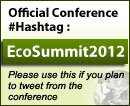« Go back to e-newsletter overview
EcoSummit 2012 E-Newsletter: August 2012
A Celebration of Silent Spring
“We shall have to count the many hidden costs of what we are doing.” ~Rachel Carson
Rachel Carson never saw the construction of a monolithic state office tower in downtown Columbus, Ohio, but today the building features a living, breathing monument to her work. The ledge on the 41st floor of the Rhodes Office Tower is now the home of peregrine falcons that faithfully hatch an egg or two, delighting Internet viewers tuned into a webcam trained on the nest.
Fifty years ago those eggs had no chance of survival. As Rachel Carson noted in her seminal work, Silent Spring, the widespread use of the pesticide DDT left bird eggs too thin to survive to the hatching stage, wiping out entire populations of falcons, bald eagles and other birds.
In the spring of 1962, The New Yorker magazine began serializing Carson’s warning that pesticides were damaging the food chain and threatening our ecosystems. That September, the articles were published in book form as Silent Spring and went on to launch the modern environmental movement.
It seems fitting that almost 50 years to the day after the release of Silent Spring, some of the leading voices of the ecological movement will be meeting just a few blocks from the falcons’ nest. More than 1,500 people from 75 countries will be in Columbus to take part in EcoSummit 2012, including scientists, economists, policymakers and corporate leaders interested in ensuring the sustainability of natural assets.
Carson gained international attention in 1962 when she exposed the dangers of pesticides and insecticides and attempts to mislead consumers about the toxic side effects of the chemicals. She argued in Silent Spring that pesticides such as DDT were entering the ecosystem with harmful side effects, including the disappearance of entire species and causing an outbreak of illnesses in humans.
Silent Spring is credited with the ban of DDT in the United States and motivating the book’s many readers, including President John F. Kennedy, to organize the modern environmental movement. Carson died of breast cancer shortly after the book’s publication.
Professor Sven E. Jørgensen, University of Copenhagen, one of the original organizers of EcoSummit, said this year’s meeting is a fitting tribute to Silent Spring.
Jørgensen said, “What better way to remember the work that made us focus on saving our natural surroundings than to examine our progress and to discuss new ideas for making our world sustainable. I’d like to think that Rachel Carson would be right at home at the summit.”
“Silent Spring started the first green wave, and it initiated the need for integrating ecology in environmental management. Several new ecological subdisciplines emerged as a result: ecological modeling, ecological economy, ecological engineering, use of ecological indicators and system ecology. It became clear that the researchers of these subdisciplines had to meet to learn from each other and to integrate the scientific results and applications into environmental management. Therefore, we started the EcoSummit meetings with the first conference in Copenhagen in 1996,” Jørgensen said.
The formal recognition of the anniversary will be at a Forum at EcoSummit 2012 organized by Patricia DeMarco, from the Rachel Carson Institute at Chatham University. Panel members include Professor Volker Hartkopf, director of the Center for Building Performance and Diagnostics at Carnegie Mellon University; Professor Eric Beckman, the co-director of the Mascaro Center for Sustainable Innovation at the University of Pittsburgh; Professor Nancy Gift, Compton chair in sustainability at Berea College; and E.O. Wilson, the Harvard University professor who authored two Pulitzer Prize winning books.
The Rachel Carson Institute’s Patricia DeMarco said Carson’s legacy reminds us how much we have accomplished and how much more is yet to be done.
DeMarco said, “The American Bald Eagle returned in great numbers after we banned DDT, but today there are more than 100,000 synthetic chemicals in commercial use and fewer than 200 have been tested for human health effects. More than 100 synthetic chemicals, some known carcinogens and mutagens, are found in the bodies of all of us, even newborn infants."
See other articles in the August 2012 newsletter:
- Food Security to Be Addressed at EcoSummit 2012
- Sustainability at the Forefront of Green Events Guide and Green Ribbon Program
- Register Now for MORPC's 2012 Summit on Sustainability & the Environment
- EcoSummit 2012 International Film Festival: Call for Submissions





